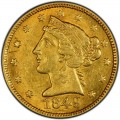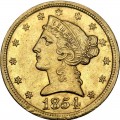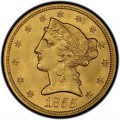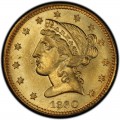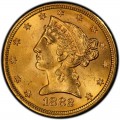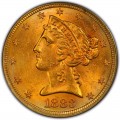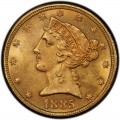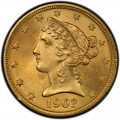- United States Coins
- Liberty Head Half Eagles
Liberty Head Half Eagles
 Liberty Head half eagle $5 gold coins were first made in 1839 and remained in production until 1908. Over the course of the interceding years, the Gold Rush unfolded in San Francisco, California; the Civil War played out between the South and the North United States; and groundbreaking inventions such as the phone, railroad, telegraph, and film production were introduced to the mass public. $5 gold coins were an important part of commerce, especially in places like the West, where gold coins would see widespread use. Gold coins were also commonly used in the major transactions in large cities. Remember, five dollars was a significant sum of money in the middle 19th century, meaning $5 gold coins would not necessarily see the heavy use that coins of smaller denominations would see.
Liberty Head half eagle $5 gold coins were first made in 1839 and remained in production until 1908. Over the course of the interceding years, the Gold Rush unfolded in San Francisco, California; the Civil War played out between the South and the North United States; and groundbreaking inventions such as the phone, railroad, telegraph, and film production were introduced to the mass public. $5 gold coins were an important part of commerce, especially in places like the West, where gold coins would see widespread use. Gold coins were also commonly used in the major transactions in large cities. Remember, five dollars was a significant sum of money in the middle 19th century, meaning $5 gold coins would not necessarily see the heavy use that coins of smaller denominations would see.
The most common Liberty Head Half Eagle specimens in lower circulated grades command a price of between $1,110 and $1,415, however there are many key dates in this series which bump that value up to two thousand dollars or more.
Liberty Head half eagles were designed by Christian Gobrecht, who also designed many other coins of the era, including Liberty Seated coinage. $5 Liberty Head half eagles weigh 8.359 grams and feature a composition consisting of 90 percent gold and 10 percent copper. That provides a net pure gold weight of 0.24187 ounces. In 1839 and 1840, the diameter of the $5 half eagle was 22.5 millimeters. By the end of the year 1840, the diameter of the coin was reduced to 21.6 millimeters, making it roughly as large as a modern-day 5-cent nickel.
While many of the earlier dates in the Liberty Head $5 half eagle gold coin series are considerably scarce, most issues from the 1880s and later are relatively common. As a general rule of thumb, Charlotte (C), Carson City (CC), and Dahlonega (D) issues are the scarcest in the series. However, there are several rare Liberty Head $5 gold coins from the Philadelphia, New Orleans, and San Francisco mints, including the 1875 (Philadelphia), 1864-S, and 1847-O whose values can be counted in the tens of thousands of dollars. Interestingly, the 1841-O has a mintage of 50 pieces, but none are known to exist today.
Below is a list of Liberty Head Half Eagle info sheets for each year of issue. Each info sheet includes detailed pricing and mintage numbers for each variant.
-
{{#owner}}
-
{{#url}}
{{#avatarSrc}}
{{name}} {{/url}} {{^url}} {{#avatar}} {{& avatar}} {{/avatar}} {{name}} {{/url}} - {{/owner}} {{#created}}
- {{created}} {{/created}}











